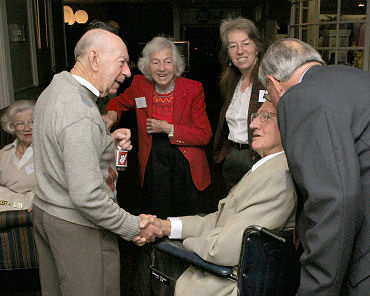|
|
Special Events Photography
by Sarah Fox
  Events photography is usually done with a single entry-level camera, a cheap lens, and a single flash mounted on the hotshoe, usually without any mini-softbox to soften the light. It is usually done by novice photographers who hold themselves out as professionals, because at its simplest level, this sort of photography is not particularly demanding of either equipment or experience. Events photography is usually done with a single entry-level camera, a cheap lens, and a single flash mounted on the hotshoe, usually without any mini-softbox to soften the light. It is usually done by novice photographers who hold themselves out as professionals, because at its simplest level, this sort of photography is not particularly demanding of either equipment or experience.
However, I do things a bit differently. I deliver an entirely different sort of product, and of course I also cost a bit more.
How is my work different? It's much more than a difference in quality of equipment (mine being professional). It's also more than my having a better grasp of camera settings and my being able to frame up a shot maybe a bit better. The biggest qualitative difference between me and almost any other event photographer in the field is that I use indirect lighting. This makes a huge difference in the appearance of a photograph. The direct flash used by most photographers makes ugly, harsh reflections off of the face, hair and glasses and is the culprit behind "red eye." It casts very harsh shadows, even if mounted on a big bracket or held away from the camera at the end of a sync cord. It makes the colors dull and the contours shallow. And it makes the background practically black, with more closely positioned people appearing white as sheets and slightly more distant people in the shadows. The indirect lighting I use is more dimentional, does not create ugly reflections or red eye, does not cast ugly shadows, and balances the light more evenly between foreground and background. My photographs appear much more similar to what an event participant would have seen. Note in the MCV dental school 50th reunion I photographed above, the woman seated in the background to the far left is lighted almost as brightly as all the people in the foreground, and there are no harsh reflections off of anyone's face.
Until now I've used shoe-mounted bounce-flash techniques, where I point my flash up and behind me, bouncing the light off of the ceiling for more diffused lighting of the scene. A flash often has a hard time auto-exposing with bounce lighting, as the power required from the flash is often too much. This often requires a lot of tweaking of flash compensation, aperture and ISO, and often the total abandonment of automatic exposure for manual exposure. This is frankly over the heads of most photographers. Furthermore, most photographers cannot tolerate the deep flash discharges required for bounce work, as the recycle times become excessively long, and their batteries are quickly consumed. My own solution to this problem has been to modify my flash for external power from a gel cel pack I carry in my pocket. That gives me very fast recycle times and very long battery life.
Unfortunately it is not possible to use bounce flash in all situations. Sometimes ceilings are too high. Sometimes they aren't white, so the bounced light has a color cast to it. Even when it works well, bounced lighting never completely solves the dark background problem. It only helps. I've recently solved these problems by building a new system of multiple slave flashes, described on my page about on-location work. Although I developed this system for architectural and commercial photography, it is also obviously useful for photography of rooms full of people. The system uses digital radio frequency synchronization each flash in the room, whose light is bounced off of either the ceiling or an umbrella. This creates very smoothly dispersed lighting that is flattering to the event participants, and it eliminates the problem of blacked out backgrounds. I can also use this lighting equipment to set up complete studio lighting configurations on-site and to light up large-scale images such as for a group portrait. This is an entirely manual form of photography that uses custom built equipment. I don't know any other photographer who is doing this. Perhaps there just aren't enough old dogs (proficient in manual photography) willing to learn new tricks (utilizing digital RF synchronization, only recently avaialble to photographers).
With all this in mind, I can offer different sorts of products for your event. In more formal settings, your group may want formal portraits, for instance as participants arrive at a dance. These can be sold in combination with a group photo taken in the middle of the event. Another popular option is a DVD or VCD (video CD) with a slide show of all the photographs from the event, playable in either a computer or DVD player. The same disc can be taken to most labs for having prints made. I have no "standard package," but if you tell me what you want and need, I can give you a quote.
Please contact me for more information about the photographic services I can provide at your upcoming event.
Links:
Home
Galleries
About Us
Photoediting Services
On-Location Services
Portraiture
Architectural Photography
Commercial Photography
Special Events
Web Design
Articles
Projects
FAQ
Contact
Site Map
Notice: All images and web content are copyrighted by Sarah Fox, Earline Thomas, and/or Graphic Fusion, will all rights reserved.
Printing or distribution of this material is prohibited.
|

